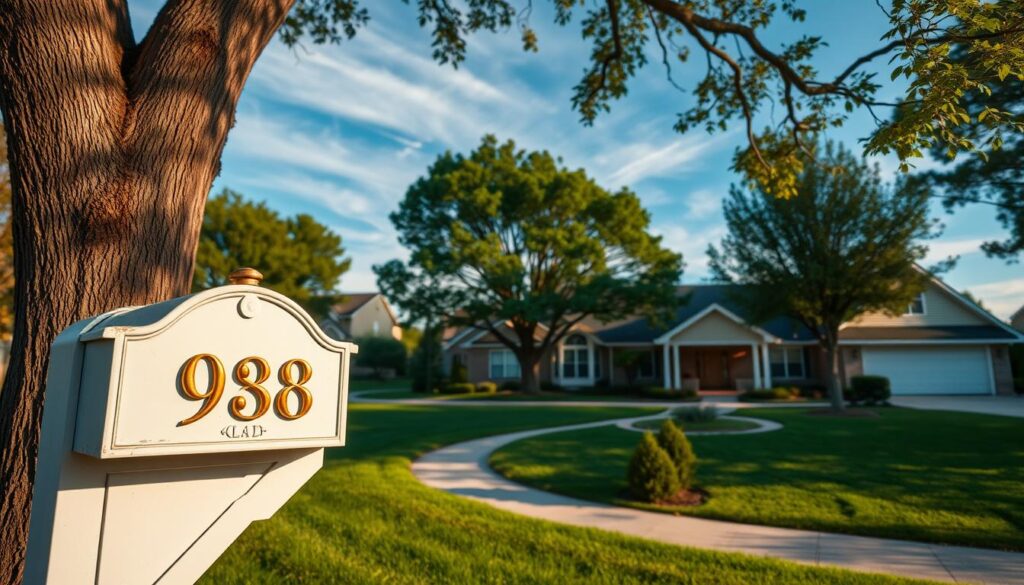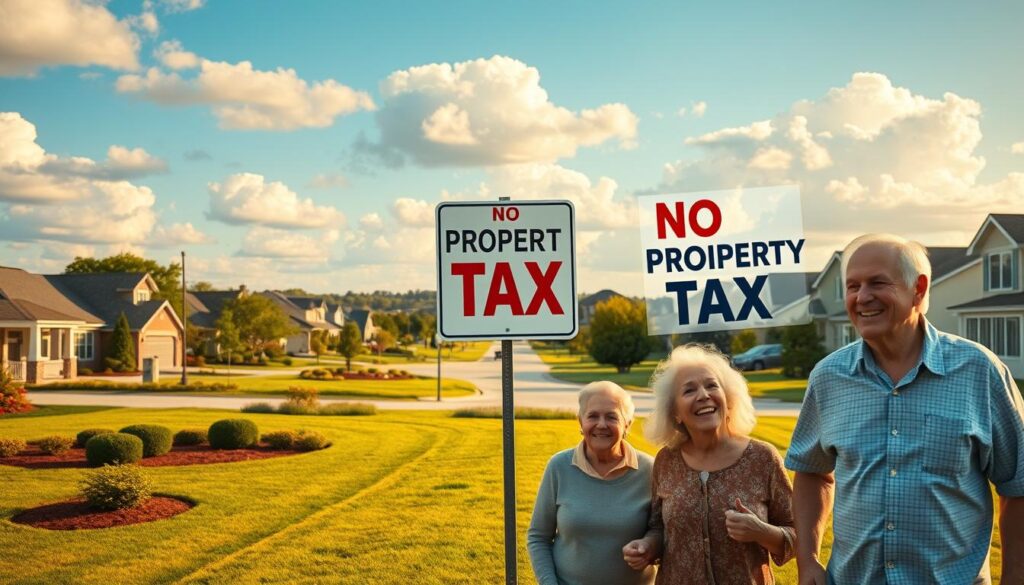Surprising fact: the average American homeowner pays about $2,869 a year in property tax, and 23 states add nearly $440 more in personal vehicle levies.
I set expectations up front: there is no U.S. state with zero real estate tax, but I show smarter options with much lower effective rates and meaningful property tax relief aimed at retirees.
My approach is simple: compare effective tax rates, typical annual tax bills, and senior-focused exemptions that cut your assessed value.
I’ll benchmark the national baseline, explain the effective tax rate (tax paid ÷ market value), and preview low-rate places like Hawaii (~0.31%), Alabama (~0.4%) and Colorado (~0.55%).
Trade-offs matter: lower property levies can come with higher sales or income levies. I’ll help you weigh total state tax exposure and estimate your likely tax bill over the next few years.
For a deeper state-by-state look and numbers I use, see this helpful guide: states with lower effective property tax.
Key Takeaways
- There is no state with zero real estate tax, but some deliver much lower effective rates.
- Average homeowner property tax is about $2,869 annually; vehicle levies add roughly $440 in 23 states.
- Effective tax rate (annual tax ÷ market value) is the best way to compare locations.
- Senior exemptions, assessment caps, and homestead rules can sharply reduce your annual bill.
- Evaluate total state tax exposure — not just one line item — before moving or buying.
Reality check for retirees: there’s no zero-property-tax state, but there are smarter choices
A more useful goal for retirees is predictable, low annual bills—not an impossible zero rate.
I cut through the myth: every state charges some form of real estate levy, so the aim should be manageable effective property tax and a stable bill over time.
Consider effective rates, local mill decisions, and senior-friendly rules. Hawaii’s effective rate sits near 0.31% with a median bill around $2,092. By contrast, New Jersey’s ~2.23% can push a yearly bill well above $8,800 on similar home values.
“Smarter choices” pair a low effective rate with exemptions, assessment ratios, or caps that slow annual increases. Those policies shrink the assessed value used to calculate your tax.
- Focus on the bill: estimate your annual tax using local effective rates, then subtract applicable exemptions.
- Check locality: counties and towns set mill rates that can shift your cost dramatically.
- Weigh trade-offs: low property levies sometimes mean higher sales or income tax elsewhere.
I’ll help you compare options so you can pick the combination of rate, relief, and long-run stability that fits your retirement plan.
What states have no property taxes for seniors?
Looking for a tax-free home? That search misses the practical wins available today.
I make this clear: no U.S. state eliminates real estate levies for retirees entirely. Instead, I focus on lowest effective rates and local programs that trim the assessed value used to calculate your bill.

The myth versus present-day reality
Zero is rare. But several places post very low effective numbers: Hawaii (~0.31%), Alabama (~0.4%), Colorado (~0.55%), Louisiana (~0.56%), Wyoming (~0.56%), West Virginia and South Carolina (~0.57%), Utah (~0.57%), Nevada (~0.59%), Delaware (~0.61%), and Washington, D.C. (~0.62%).
How to reframe your search
Prioritize a low effective tax rate plus property tax relief: homestead exemptions, reduced assessment ratios, caps, or circuit breakers. Compare county-level bills, test scenarios by home value and eligibility, and weigh other state taxes like income or sales.
| Location | Effective Rate | Typical Median Bill | Senior Relief |
|---|---|---|---|
| Hawaii | ~0.31% | $2,092 | Homestead valuation rules |
| Alabama | ~0.40% | Sub-$1,000 | Senior exemptions & caps |
| Colorado | ~0.55% | Modest | Partial-value exemptions |
| Washington, D.C. | ~0.62% | Low-mid range | Circuit breaker options |
How property taxes are calculated and capped in practice
A clear formula beats guesswork: learn how valuation, rates, and caps combine to make your annual bill. I start with the math you can use today: the effective property tax rate equals total annual property taxes divided by your home’s market value. That ratio is the easiest way to compare across counties and states.
Assessed value, exemptions, and local mill rates
Local rules often tax only a fraction of market value. That fraction is the assessed value. Examples: Alabama uses a 10% residential assessment; Colorado applied a 6.7% residential rate in 2023–2024 plus a $55,000 primary residence exemption.
Mill rates multiply the assessed value to create your tax amount. Apply exemptions or homestead relief first, then the mill rate to get the final tax bill.
Reassessment limits and caps that control year-over-year increases
Many states cap how fast assessed value can rise. South Carolina limits market value growth to 15% over a five-year reappraisal cycle for owner-occupied homes. Oklahoma caps homestead assessed growth at 3% annually. California’s Prop 13 ties taxes near 1% of assessed value and limits annual assessed increases to about 2% until a sale.
- Model both scenarios: compute your tax bill with and without senior exemptions or circuit-breaker credits.
- Track reassessments: knowing the cycle and local mill proposals helps you forecast costs over several years.
States with the lowest property tax rates right now
I rank the lowest-rate locations so you can compare real bills, not just percentages.

Hawaii: The nation’s lowest median effective rate (~0.31%) yields an average annual bill near $2,092 despite high home values. That shows low rates can still mean sizable dollars when market prices are high.
Alabama: A ~0.40% effective rate plus 10% assessment of market value produces median bills around $718. Recent proposals would cap assessed growth to help keep costs stable.
Colorado: A 6.7% residential assessment ratio and a $55,000 exemption cut the taxable share of value, producing about a 0.55% effective rate and modest average bills.
Louisiana and Wyoming: Homestead breaks in Louisiana and a 9.5% valuation rule in Wyoming hold annual amounts low—median bills sit near $1,127 and $1,609 respectively.
Other low-rate markets: West Virginia and South Carolina sit near 0.57%. Utah, Nevada, Delaware, and District Columbia post slightly higher effective numbers; local mill rates and exemptions drive the final tax bill.
- Tip: Model a $300k–$600k home in any county to see your likely annual amount before you buy.
States with no income tax and relatively manageable property tax burdens for seniors
I focus on states that waive an income levy while keeping annual home levies manageable for retirees. This helps align retirement withdrawals and dividends with a single tax strategy: avoid state income levies, then manage the annual house bill.

Quick summaries:
- Mississippi: Exempts traditional retirement income and posts one of the lowest median bills (~$1,161–$1,189) with an effective rate near 0.67%.
- Tennessee: No income levy; median annual bill about $1,376–$1,400 and residential assessment at 25% of appraised value.
- Wyoming: No income levy, ~0.56% effective rate, median bill near $1,609–$1,659, plus low combined sales taxes.
- Nevada: No income levy and sub-$2,000 median bills (~$1,889–$1,970); watch higher combined sales taxes despite grocery exemptions.
- Florida: No income levy and strong homestead protections that reduce assessed value and slow annual increases; median bill ~ $2,555.
- Texas & Alaska: Both lack an income levy but can raise total tax exposure: Texas by higher home levies (~$4,111 median), Alaska by local sales add-ons (~$3,785 median bill).
Bottom line: in income-tax-free locations, your withdrawals avoid state tax, so the annual house bill becomes a key lever. Compare your planned home value, likely exemptions, and spending pattern to choose the best tax mix.
Senior-focused property tax relief programs that reduce your tax bill
Senior homeowners can cut decades off their annual tax burden with targeted relief programs that change how value is counted.
I outline three main tools that matter: homestead exemptions, circuit breakers, and deferrals. Each reduces your assessed value, caps what you pay, or delays payment until it fits your cash flow.
Homestead exemptions and assessment breaks
Homestead rules remove a portion of market value from taxation. Colorado combines a low residential assessment rate (6.7% in 2023–24) with a $55,000 primary residence exemption. Louisiana uses broad homestead relief to lower assessed value and steady yearly bills.
Circuit breakers: income-tied caps
Circuit breakers limit your tax to a share of income. These credits stop property levies from overwhelming a fixed retirement budget.
Deferrals and valuation caps
Deferrals let qualified owners postpone tax payment until sale, preserving cash flow now. Caps manage growth: South Carolina uses a 4% owner-occupied ratio and a 15% five-year cap; Oklahoma limits homestead assessed growth to 3% annually; Tennessee assesses residential at 25%.
| Relief Type | Example | Primary Benefit |
|---|---|---|
| Homestead exemption | Louisiana, Colorado | Reduces assessed value, lowers annual bill |
| Circuit breaker | Income-based state credits | Caps tax relative to income |
| Deferral | State/local deferral programs | Delays payment until sale, preserves cash flow |
| Assessment/cap rules | California Prop 13; SC; OK | Limits year-over-year assessed growth |
Action: check eligibility, deadlines, and local add-ons. File promptly—these relief paths can save hundreds or thousands each year.
High property tax states to weigh carefully before buying
High tax bills can quietly erode retirement savings — focus where exposure is worst. I call out markets where tax rate and price combine to create large annual burdens for homeowners.
New Jersey: the steepest burden
New Jersey posts the highest effective property tax rate at ~2.23%. That yields an average annual property tax near $8,897 on a median home value of about $502,120.
Bottom line: this one can stress a fixed-income budget fast.
New Hampshire and Connecticut: elevated annual bills
New Hampshire (~1.93%) and Connecticut (~1.79%) both translate to median bills near $6,200. Expect significant year-to-year costs even on moderate homes.
Illinois and Vermont: high rates, different prices
Illinois shows a ~2.08% effective rate; a roughly $280k home can still produce a near-$4,912 annual bill. Vermont (~1.83%) faces rising homestead education levies in 2024–2025 that boost many bills.
Price-driven high bills: NY, MA, RI, WA
New York and Rhode Island (~1.4%) and Massachusetts (~1.14%) generate large bills because home values are high. Washington’s ~0.87% rate looks low, but a median home near $631,060 inflates the annual amount.
- Action: always model your target home price against local effective rates.
- Verify reassessment trends, exemption rules, and whether local levies may change over the coming years.
Buyer’s Guide checklist for choosing a tax-friendly place to live now
Start by pinning a clear number: your target home’s market value, then convert that into an annual cost using the local effective tax rate.
Estimate your annual bill
Multiply market value × effective property tax rate, then subtract any applicable exemptions to get your expected annual tax bill.
Layer in other taxes
List every other state levy: income, sales (note grocery and medical exemptions), vehicle personal property, and estate or inheritance exposure. Use the federal estate threshold ($13.99M in 2025) as a planning anchor.
Match home type to assessed value rules
Confirm owner-occupied assessment ratios, homestead breaks, senior credits, circuit breakers, and deferral options that fit your income and ownership plan.
Consider the five-year outlook
Review reassessment cycles, valuation caps (2%–15% limits), and pending legislation that may change assessed growth. Factor proposed bills into your five-year cost projection.
- Validate local mill rates and special assessments that add to the base amount.
- Build downside scenarios: price growth without relief vs. with relief.
- Document filing steps and deadlines to capture credits in year one of ownership.
- Create a decision matrix scoring predictability, annual amount, relief depth, and five-year stability.
Sample senior scenarios and how location choice changes the tax bill
I map realistic senior scenarios to show how location can swing your annual tax bill by hundreds or thousands.
Fixed-income homeowner targeting the lowest annual bill
I model a $300,000 home in Alabama, Wyoming, and South Carolina. Alabama’s ~0.40% effective rate yields a tiny annual amount — often under $1,000 after exemptions.
Wyoming and South Carolina give modest bills too, but local mill rates and assessed value caps change results by county.
Downsizer seeking homestead protections and caps
Choose South Carolina or California to lock assessed growth. Caps and homestead rules slow year-to-year increases, keeping your yearly tax predictable.
Investor-landlord balancing low taxes with rental demand
Low property taxes in Alabama or Wyoming boost net operating income. Still, check county mill rates and rental market strength before you buy.
- Tip: circuit breakers can cap taxes as a share of income.
- Watch: improvements may trigger reassessment and raise your bill even with caps.
- Case: Hawaii’s low effective rate still produces higher dollars when market value is high.
How to compare states beyond property taxes in the present market
A full-tax view shows where retirement dollars stretch farther. I recommend weighing income levies, sales on essentials, and estate exposure alongside any local property tax relief.
Social Security and retirement income taxation by state
Nine states still tax Social Security: Colorado, Connecticut, Minnesota, Montana, New Mexico, Rhode Island, Utah, Vermont, and West Virginia (phase-out by 2026). Missouri, Kansas, and Nebraska removed that tax in 2024.
Sales tax on essentials: groceries, prescriptions, medical equipment
Four places lack state-level sales tax: Delaware, Montana, New Hampshire, and Oregon; Alaska allows local levies. Louisiana and Tennessee top combined rates near 9.56% — that hits grocery and medical costs when exemptions are limited.
Estate and inheritance tax exposure for legacy planning
The federal estate exemption is $13.99M in 2025. Still, 12 states plus D.C. levy estate taxes and six impose inheritance taxes. If legacy matters, consider no-estate-tax locations like Florida, Wyoming, Nevada, or South Dakota.
“Optimize the full stack: property, income, sales, and estate.”
- Checklist: Social Security taxation, retirement income rules, sales exemptions, estate exposure.
- Model your expected income and home value over five years before you move.
- Coordinate withdrawals and claim eligible credits or exemptions promptly.
Conclusion
The practical win is a low, steady tax bill backed by local relief and caps. I confirm: no U.S. state eliminates real estate levies entirely, but targeting low effective rates and senior relief cuts your annual cost meaningfully.
Top low-rate choices to check: Hawaii, Alabama, Colorado, Louisiana, Wyoming, West Virginia, South Carolina, Utah, Nevada, Delaware, and District of Columbia—verify county differences and mill rates.
Use homestead exemptions, assessment caps, circuit breakers, and deferrals to trim assessed value and stabilize your bill. Watch high-rate markets like New Jersey and model total state exposure: income, sales, and estate rules matter too.
Next step: shortlist three locations, run the numbers with local effective rates, file exemptions on time, and consult your local tax office or advisor before you buy.

